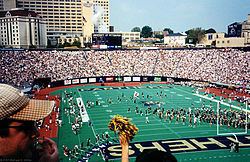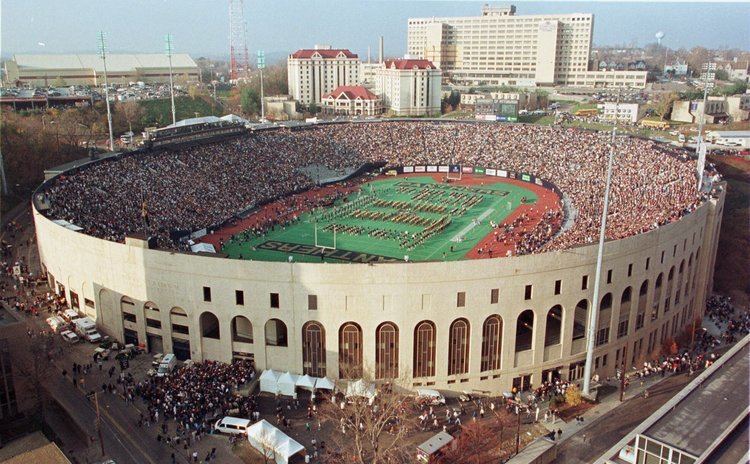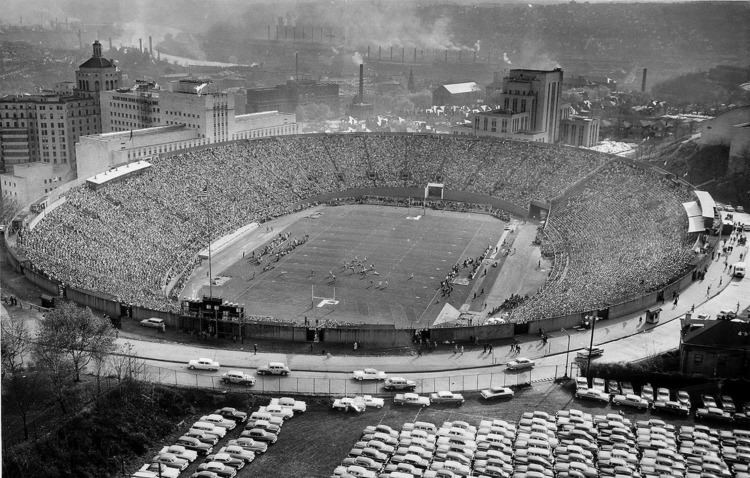Broke ground August 7, 1924 Capacity 69,400 Demolished December 1999 | Closed November 13, 1999 Opened 1 September 1925 | |
 | ||
Full name Terrace StreetPittsburgh, PA 15260 Built August 1924 to September 1925 Similar Forbes Field, Exposition Park, Josh Gibson Field, Greenlee Field, Fitzgerald Field House | ||
Pitt band last out of the hole at pitt stadium 1999
Pitt Stadium was a stadium located on the campus of the University of Pittsburgh in the Oakland section of Pittsburgh in the U.S. state of Pennsylvania from 1925 to 1999. It served primarily as the home of the University of Pittsburgh's football team, the Pittsburgh Panthers. It was also used for other University sporting events, including Pittsburgh Panthers basketball, baseball, rifle, track, and gymnastics. Designed by University of Pittsburgh graduate W. S. Hindman, the US$2.1 million stadium was built after the seating capacity of the Panthers' previous home, Forbes Field, was deemed inadequate in light of the growing popularity of college football. Pitt Stadium also served as the second home of the Pittsburgh Steelers, the city's National Football League (NFL) franchise. After demolition, the Pittsburgh Panthers football team played home games at Three Rivers Stadium in 2000, before moving to Heinz Field in 2001.
Contents

Pitt stadium
History

The Pittsburgh Panthers played home football games at the Pittsburgh Pirates' Forbes Field from 1909 to 1924. In the 1910s and 1920s, Pitt football achieved great success under head coach Glenn Scobey "Pop" Warner, completing several undefeated seasons and claiming several national championships. The popularity of college football was rising across the country and in Pittsburgh. Subsequently, due to tickets reserved for alumni and students, the general public's demand for tickets to see Pitt play at Forbes Field surpassed supply. In the early 1920s, the University administration decided to build an on-campus stadium to alleviate the seating problem. The University purchased nine acres of land adjacent to university property for the Pitt Stadium site. University and private funding provided US$2.1 million for site acquisition and construction. W. S. Hindman, a Pitt graduate, was the stadium's designer and engineer. The Turner Construction Company built the stadium from August 7, 1924 to September 1, 1925. The 791 feet (241 m) by 617 feet (188 m) stadium was designed to hold a capacity of 69,400 with provisions for an upper deck that could provide for an additional 30,000 seats. On September 26, 1925, Pitt played its first football game at the new Pitt Stadium, a 26-0 victory over Washington and Lee. Starting in 1929, the stadium also hosted the football team of the Carnegie Tech Tartans, which played their home games there on a split schedule with the Panthers until 1943.

By the 1940s, new safety rules from the city fire marshal prohibited temporary bleacher seats on the rim of the stadium and in the track area. In order to provide comfort to larger spectators, the Department of Athletics also widened seats from 16 to 18 inches, thereby reducing the final capacity to 56,500. The original grass surface was replaced with AstroTurf in 1970. In 1984, SuperTurf was installed, but after six years AstroTurf once again became the stadium's playing surface. In the late 1970s, the original 17 miles of wood seating was replaced with metal bleachers. Temporary lighting was installed at Pitt Stadium in 1985, but was made permanent before the 1987 season. A scoreboard was installed at the eastern end of the stadium in 1995; this was followed in 1997 with the installation of the PantherVision videoboard, which allowed fans to see instant replays of the games. The highest attended game took place on October 29, 1938, when 68,918 spectators saw the Panthers defeat Fordham 24–13.

The Pittsburgh Steelers played home games at Forbes Field from their 1933 inception to 1957. They first played at Pitt Stadium during a November 15, 1942 exhibition match for U.S.O. charity against the Fort Knox "Armoraiders". From 1958 to 1963, the Steelers split home games between Forbes Field and Pitt Stadium. Fans were able to purchase season ticket packages for one site or the other. In 1964, the Steelers began to play home games exclusively at Pitt Stadium, which they continued until moving to Three Rivers Stadium in 1970. Of historic note, the iconic photo of New York Giants quarterback Y. A. Tittle, helmet-less, bloodied and kneeling, was taken at Pitt Stadium on September 20, 1964 following a Giants' loss to the Steelers. The photo, taken by Pittsburgh Post-Gazette photographer Morris Berman, now hangs in the Pro Football Hall of Fame.

In the late 1980s, then athletic director Ed Bozik unveiled a massive overhaul plan for Pitt Stadium that entailed gutting the stadium and rebuilding it from the ground up. In addition to luxury boxes, the $55 million renovation would have added a dome to the stadium.
The final game at Pitt Stadium took place on November 13, 1999, when the Panthers defeated Notre Dame 37–27. The final touchdown in Pitt Stadium was scored by Kevan Barlow at 7:06PM, just minutes prior to fans rushing onto the field. Some of the 60,190 spectators—the largest crowd in 16 years—ran onto the field with 9 seconds remaining in the game, tearing down both goal posts and removing pieces of turf. The Panthers played their home games of the 2000 season at Three Rivers Stadium, before moving to Heinz Field in 2001. Demolition of Pitt Stadium began in December 1999. Concrete from the stadium was ground and left on site for use in the Petersen Events Center and student housing which was built at the site.
The Pitt Pavilion
The Pitt Pavilion, located beneath the ramps inside Gate 2 of Pitt Stadium, was the home of the Panthers basketball team from January 6, 1925 (with a loss to Geneva College) to February 26, 1951 with a Backyard Brawl victory. The Pavilion contained both permanent and temporary bleachers for a capacity of approximately 4,000 spectators. However, with only one dressing room, visiting teams were forced to use the visitors' football locker room to dress and then walk 60-yards outdoors to get to the basketball court. Future coach John Wooden and Notre Dame's Moose Krause were basketball stars that played against the Panthers at the Pavilion. While there, the Panthers themselves featured several All-Americans, including Basketball Hall of Fame inductee Charlie Hyatt, and recorded the school's only undefeated season in 1928. On February 26, 1951, the Panthers won the final game at the Pavilion, defeating rival West Virginia 74-72 on a last-second shot by Scott Phillips, his only points in the game. The basketball team moved to the Fitzgerald Field House for the 1951-52 season. The Pavilion also hosted WPIAL playoff games and pre-season games of the American Basketball League's Pittsburgh Rens. The Pitt Pavilion was removed in 1994 when ground was broken for the stadium's Duratz Athletic Complex.
